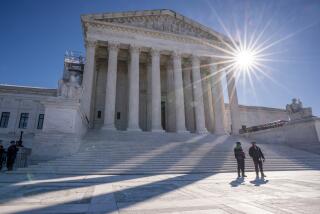Court Lets Cable Firms Bar Rivals From Internet Lines
- Share via
The Supreme Court ruled Monday that cable TV companies didn’t have to share their high-speed Internet lines with rivals, a decision consumer groups said would stifle competition in the rapidly growing market for broadband.
In a 6-3 decision, the nation’s high court said the Federal Communications Commission acted reasonably in finding that cable companies need not operate their networks as so-called common carriers the way telephone companies do.
The case is likely to help limit the choices most residential customers have for high-speed Internet access to their local phone company and their local cable company.
Cable and phone industry leaders hailed the decision, but the Consumer Federation of America called it a “grave error, both harming consumers and stifling entrepreneurial innovation.”
The decision bolsters efforts by telephone companies such as SBC Communications Inc. to kick competitors such as EarthLink Inc. off their networks. That’s because it revives a 2002 FCC proceeding on rules that would give phone companies the same sort of exclusive control over their digital subscriber line, or DSL, service. The agency had put the action on hold pending a final court ruling.
FCC Chairman Kevin J. Martin said the Supreme Court opinion offered “a framework for broadband that can be applied to all providers.” He said the agency now could “move forward quickly” to make the DSL rules final, but it may still take many months to craft and pass regulations.
Even so, some phone companies already are undercutting smaller Internet service providers with lower retail prices in the marketplace.
“You now can buy consumer-grade DSL from SBC for $15 [a month], and we pay three times that just for access to the line,” said Jim Pickrell, owner of Brand X Internet Services, a tiny Santa Monica company that was at the heart of the case.
Brand X started in 1994, when all Internet surfers used standard telephone lines to go online. It was one of thousands of ISPs popping up to help people use the Internet. Brand X grew to 1,500 customers by 2000, but cable broadband and DSL companies began wooing customers to high-speed connections. Then the tech bubble burst in 2001, and Brand X began scaling back.
With cable’s faster rise, Brand X tried leasing cable lines but got nowhere. Brand X now serves just 350 customers. Without access to the lines that deliver high-speed Internet, Pickrell said he would “go down with the ship.”
“It’s not looking good at all,” he said. “It looks like the people in charge of regulation are planning to put us out of business, not 10 years from now but right now.”
SBC, California’s dominant local phone company, and Verizon Communications Inc., the nation’s largest phone company, said the decision should spur the FCC to put telecom firms on a level field with cable firms. Both companies said the government should steer clear of broadband regulation.
For most ISPs, Monday’s decision won’t mean much in the short term because they didn’t have access to most of the cable network anyway, said Michael Jackman, executive director of the California ISP Assn., a trade group.
Longer term, though, customers are moving away from the slow dial-up access to broadband. About half the households with Internet access use high-speed connections, and about 98% of those connections are supplied by cable and phone companies. Six of 10 broadband customers use cable modems.
Analysts said giant ISPs such as EarthLink, which joined Brand X in the Supreme Court case, might have to take another look at how they operate. But David Baker, EarthLink’s vice president of law and public policy, said the company would continue its current course, which includes offering broadband over phone lines.
He also said the company would seek changes in federal law to “ensure customer choice and future deployment of advanced communications services and applications.”
That includes wireless broadband service. The service is available to households in many rural and hard-to-reach areas, as well as some urban pockets such as Cerritos, which isn’t fully served by either DSL or cable modem service.
Some companies are serving small business with high-speed wireless, but none is putting it into the mass market yet. Outside the home, so-called wireless hot spots flourish at coffee shops, bookstores, airports and other public places.
Of more than 500 ISPs operating in California, Jackman said, only a few operate on wireless networks.
EarthLink and others are “aggressively pursuing wireless platforms,” Baker said. “We do see a lot of promise, but that doesn’t change the fact that 98% of all residential broadband is either DSL or cable.”
At issue in the Supreme Court case was whether cable modem access was an information service, subject to few regulations under the Telecommunications Act of 1996, or a heavily regulated telecommunications service. Earlier in the case, the U.S. 9th Circuit Court of Appeals deemed the transmission of the Internet services a telecommunications service, subject to such rules as opening networks to rivals.
But the high court said the appeals court should have deferred to the FCC’s judgment in this case because the law was ambiguous and the agency’s interpretation of it was reasonable. The opinion, written by Justice Clarence Thomas, gave some hope to consumer advocates because it indicated that the FCC could change its mind.
Former FCC official Blair Levin, now an analyst at Legg Mason Equity Research, said the commission would be unlikely to alter its decision and force cable companies to open their lines because it wanted to encourage development of new technologies.
“The real issue is, when do you get that third pipe into the home and how will that work?” he said.
More to Read
The biggest entertainment stories
Get our big stories about Hollywood, film, television, music, arts, culture and more right in your inbox as soon as they publish.
You may occasionally receive promotional content from the Los Angeles Times.










